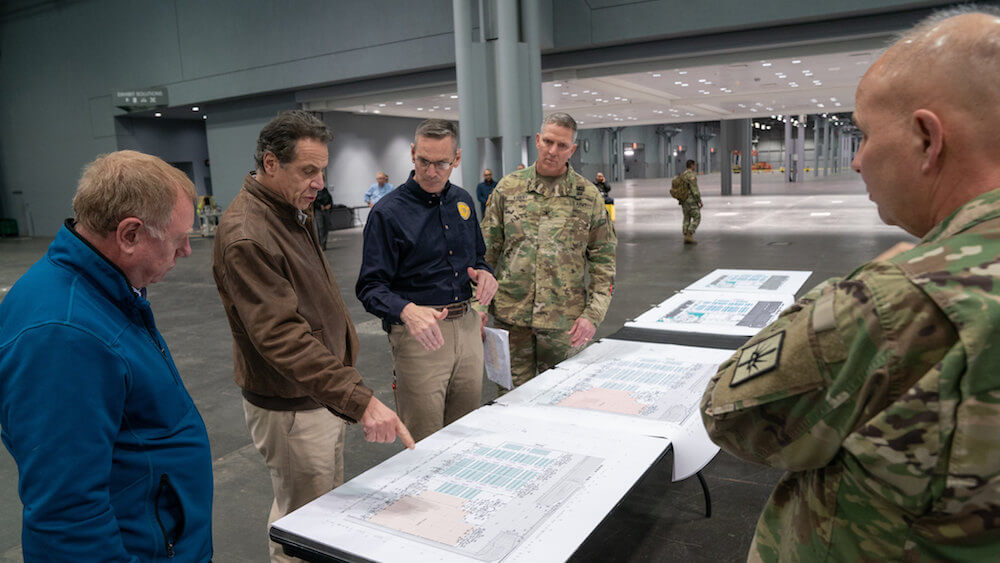
Gov. Andrew Cuomo (second from left) and other officials discuss the layout of Javits Center’s temporary hospital. Also shown, from left, are Alan Steel, Javits Center president and CEO; Cuomo; Patrick Murphy, commissioner of New York State Division of Homeland Security and Emergency Services; Col. Thomas D. Asbery, New York District of the U.S. Army Corps of Engineers, and Major Gen. Raymond Shields, New York National Guard.
When Convene spoke with Alan Steel, president and CEO of the Jacob K. Javits Convention Center in New York City, he couldn’t exactly pinpoint when talks of transforming the convention center into a temporary hospital began without looking back at his emails — the past few weeks, he said, have been a bit of a blur.
However, Steel said, the plan to have the convention center provide emergency aid in the form of hospital space in the COVID-19 crisis “came together fairly quickly.” The Army Corps of Engineers was asked by Gov. Cuomo to identify potential sites to build medical stations, “and so they came to visit us,” he said. “We showed them the facility, we listed our capabilities, we talked to them about what we might be able to do, and from there on in, it became fairly evident what we were going to be asked.”
The Javits Center team mobilized immediately to work with the Army Corps of Engineers in designing the space, in addition to working with contractors like T3, GES, and Freeman to package materials that could be used to build patient units on level three of the building.
“Basically, when I first met with the Army Corps of Engineers, I said to them, ‘We do this every day. We’re in the event business. At Javits, we do 175 events every year, so you’re just really another event for us,’” Steel said. All that was necessary was for the Army Corps of Engineers to tell him what they needed, he added.
The main difference in this case, Steel said, was that there was no event producer to oversee the process. “We stepped into that gap, and we acted as a liaison between the Corps of Engineers and the various contractors, to make sure that they could have what they wanted.”
From start to finish, phase one of the operation took less than two weeks. The hospital, which is being operated by FEMA, began accepting patients in its 1,000-plus beds on Monday, March 30, and the building’s first level is now acting as a receiving and distribution center for medical supplies.
The medical supplies are coming into New York “and then the National Guard is breaking them up into various packages that are destined for other locations in the city and state, and distributing there,” Steel said, “so we have dual functions.”
When the second phase of the operation is completed — Steel estimated it will be accepting patients by the second week in April — the convention center hospital will expand to approximately 3,000 beds. At the end of phase three, which is still being planned, the convention center could potentially accept more than 4,000 patients, if necessary.
“The plan from our perspective is to work with the contractors, build the units, get them stocked with electric, Wi-Fi, and any of the other connections they make, and then hand them over to the medical staff,” Steel said. From there on out, the medical staff will run the facility as they would any hospital space, and “all we do at that point is make sure the air conditioning is working and that the lighting is on, that the plumbing’s working,” Steel said.
Future Planning
Javits Center has been used in other emergencies — it served as a command and control center for FEMA in the aftermath of the 9/11 terrorist attacks, and also had some minor government operations running after Hurricane Sandy in 2012, Steel said. But has never been used as a hospital space before. The experience, Steel said, has made him want to work more closely with FEMA to move even faster in the event of a future crisis.
“I think there’s a lot [more] work that we could do with FEMA, and I’ve had conversations with FEMA already about pre-planning for this kind of disaster,” Steel said. He explained that the government procurement process can be slow, which sometimes hinders how quickly facilities can mobilize for emergency aid.
“We could have, as convention centers, pre-planned contracts with FEMA that would say, ‘If there’s a disaster, here’s what we can do.’ And then when there is disaster, you press the button and the whole machine rolls out. Contractors roll out with their hard walls, electricians roll out with the power,” Steel said. Even though the center “did an amazing job when you can think of how quickly it all happened,” he added, having plans already in place would enable them to “do it even better.”
Being pressed into this kind of disaster-relief service has great value for all convention centers, Steel said. “It’s an important thing we’re doing,” he said. “I think that not only can it be something that we do that will help the building — because we will be occupied and we will be paid for the work that we’re doing, so there is a revenue-generating element to it — but you’re also doing something for the community, and that’s obviously hugely important.”
Casey Gale is an associate editor at Convene.
What Events Professionals Need to Know About COVID-19
PCMA has created a COVID-19 resources page to help event professionals find reliable information about the pandemic and to share events industry-related resources to ensure they are prepared now and in the future.
